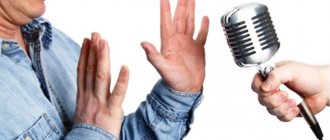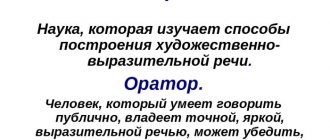Interaction and mutual understanding between listeners and the speaker are important criteria for this type of human relationship: without them, the effectiveness of the speech is practically absent, because there is no unity between the speaker and his audience.
It is important for the speaker to know how to maintain the interest of the audience, how to make them feel the issue he is talking about, how to influence the understanding and assimilation of the material by people from the audience. Therefore, a number of requirements are presented to the lecturer, compliance with which is necessary for effective interaction with the audience. You also need to understand the psychology of the group of listeners.
Introduction
Establishing contact with the audience begins with the formation of eye contact. I will give the most primitive example, which will immediately clarify why it carries such great significance. Tell your loved one "I love you." Do this three times. The first time - looking straight into the eyes, the second time - looking somewhere to the side, the third time - looking at another person. After each such confession, pay attention to what this person’s reaction will be to your words. Just try it and you will see how much eye contact increases the significance of your words in the eyes and mind of the interlocutor.
The same approach applies to public speaking, and all for one simple reason: the optic nerve is about 50 times thicker than the auditory nerve. It is through visual images, that is, with the help of our eyes, that we absorb about 90% of all information about the world around us. It is your view of the public that determines how they perceive you. Often, a speaker's eyes reveal more information about him than his speech.
ADVICE. This material is a logical continuation of the articles “Fear of Public Speaking”, “Preparation for Public Speaking” and “Structure of Public Speaking”. For a more complete and in-depth understanding of the topic, I recommend that you also read it.
Where does the performance begin?
As I discussed in the previous article, “The Structure of Public Speaking,” the initial phase of any such event is establishing contact with the audience. Here we will figure out how to achieve the same effect, but almost without words. To do this, it is necessary to give your face a friendly look with a slight smile when going out to the audience. As usual, it is important not to overdo it, not to squeeze it out of yourself and not to stretch your mouth to your ears, otherwise your falsehood will be extremely obvious. Be natural and sincere in expressing your feelings.
Once in front of the public, take your time to look at everyone present. Take a quick look at the faces and try to look into the eyes of literally each of them. If you catch a glance from someone sitting in the hall, nod slightly in response to emphasize that you noticed it. Even if you see everyone present for the first time and none of them is familiar to you, noting their eyes with your quick glance, you thereby establish subconscious contact with them. Then, during the entire event, this contact will remain quite firmly. This is exactly how the initial contact with the audience should be.
When is dialogue not needed?
Perhaps in large halls, at very solemn, official events, dialogue can be dispensed with. If you have a sales presentation or information about making a decision, dialogue is required. However, the more the presentation is from a formal lecture or stadium entertainment, the less the need for dialogue. One-man performances most often do not include dialogue, just like Nobel lectures. Although why not? I'd try it.
In any case, no one forbids you to ask questions to the audience - just don’t expect an answer to them. Such questions without an answer are called (as I'm sure you knew) rhetorical. Simon Sinek's famous "Start with Why" talk - over 44 million views - begins with the questions: "Why are some people able to achieve results that defy all notions of what is possible?" and “Why are Apple so innovative?” Of course, no one expects the audience to immediately rush to answer these questions; this is simply a technique to attract attention, interest, and make people think.
Rhetorical questions have a bad reputation. We say “well, this is a rhetorical question” when we mean that this is some kind of boring, stupid, passing question. But in general there is nothing wrong with rhetorical questions. A question as a form attracts more attention than a statement. Just not anyone. Unfortunately, there must be some other content in the question.
Establishing contact with the audience
As we have already found out, establishing eye contact, speaking in the language of analogies, is not chaotic bombing, but targeted missile strikes. It is useless to try to establish contact with the entire audience, because this is simply impossible. Instead, make eye contact with everyone in the audience. You may think that this may take quite a lot of time and will distract you from the main task, but in practice, everything is much simpler. Our eyes can move at incredible speeds, allowing you to change direction in just a split second. Give literally a split second to every glance you meet from the audience, so you can establish contact and reach a large number of listeners in a short period of time. Your task is to glide over your eyes, but not to linger on them.
In the first seconds of your speech, when you instantly skim across faces and establish contact with the audience, namely with those listeners who are already looking at you. Then those who usually fiddle with their phones or tablets during such events also raise their eyes. The moment you begin your speech, they will raise their eyes and you will meet them with yours. After such eye contact, when a person sees your oncoming gaze, he will subconsciously conclude that you see him among the entire crowd and may even be following him. This will encourage him to listen to you more attentively and no longer lower his eyes back to the gadget. Next, during the speech, wait for the moment when those listeners who are not accustomed to looking at the speaker at all raise their eyes. No matter what they do while listening to you, sooner or later they will raise their eyes and, having discovered your oncoming gaze, they will not lower them for a long time.
Why ask questions to the audience?
- This increases the involvement of the audience. Interactive presentations are listened to more attentively, people are more attentive, and this is understandable: a question can come at any moment.
- This helps combat what's called creeping determinism, a cognitive bias in which listeners have the illusion that they already know all the material. If you tell me something like, “The Battle of Waterloo happened in 1815,” people will shrug and say, “Yeah, sure.” However, if you first ask them the question: “In what year did the Battle of Waterloo take place?”, it turns out that they have a very rough idea of the military history of the 19th century. This trick works even better when you're talking about experimental science: you tell the audience about the conditions of the experiment, and then ask them to predict the outcome. If you simply tell people the result, the thought often arises: “Well, yes, it’s so obvious, why did they even do this experiment?” If you first put the question of the results to a vote, it immediately turns out that the results are not so obvious and that there are a lot of different opinions in the group.
- You obtain a “broadcast license” from the group. If you ask an important question and the group doesn't know the answer, you have the right to talk, you can give the answer and explain it. You need. No one complains about the “primitive level of the lecture” if, in response to the question: “Raise your hand, who knows...” three out of eighty people raise their hand. This is not a primitive lecture, this is a group that has come together. You can also use questions to explain. The process of explanation often reveals what the audience already knows and what does not need to be explained. This saves a lot of time on explanations.
- You improve the memorability of the material. In the second chapter, I already cited research: preliminary questions help the audience better remember the material, and not just the material about which the questions were asked. This appears to be because it is easier for audiences to maintain attention when they are waiting for questions or when they are “invested” in thinking about the answers.
- The interactivity makes the performance unique for each listener; it’s something you can’t watch on YouTube. Even if I just raise my hand in a crowd of several dozen (or even hundreds) people, I’m raising my hand. I won't raise my hand while watching YouTube because nothing depends on it. Here I am participating, this is my performance too.
- Asking for the audience's opinion is the best way to show that the audience is interesting and important to you. The audience loves it, it’s a plus for your karma.
Mistakes in working with the audience
The most common mistake you can make when connecting with your audience is overlooking parts of it. Often these are the back and side rows, that is, the extreme seats at the end of the hall and along its flanks. As a rule, it is from these places that the most sensitive or provocative questions are often asked. It is in these rows that people rustle, click, whisper, nervously cough and even giggle mischievously all the time. What is the reason for this? As a rule, the fact is that these places are usually not given enough attention, which is also explained by the level of your professionalism, that is, the ability to cover and captivate everyone present with the topic.
As you know, the viewing angle of a beginner in public speaking is about 35 degrees, while that of an experienced speaker is up to 45 degrees. In other words, one of the popular mistakes in working with the public is establishing contact with the audience exclusively within your own viewing angle, which allows you to work only with its middle. It is with those listeners who are in the central part of the audience that good eye contact is often formed from the very beginning to the end of the speech. Representatives of these particular places listen carefully, nod their heads and demonstrate interest in every possible way.
How to find out if contact has been established
The surest way to determine whether the interaction between the speaker and the audience is established is to observe its reaction to the construction of the speech. It is important to pay attention to details. After all, even absolute silence while delivering a speech does not guarantee being on the same wavelength.
The fact is that the speaker can be perceived without breathing, for fear of missing even a word, or they can organize “polite silence.”
In the latter scenario, the listeners do not disturb the order, but they also do not perceive the speaker, do not work together on the theses prepared by him, and the techniques are perceived indifferently. The silence is caused only by the desire not to disturb.
Therefore, the key factors for establishing contact are considered to be a noticeable reaction to the theses, when attention is expressed by actions noticeable to the naked eye - this is an interested posture, an attentive look, subtle nods, support with appropriate laughter and applause.
The contact between the audience and the speaker is also judged by the way the speaker carries himself. The absence of errors in speech, frequent addresses to the audience, involving them in dialogue, all these are sure signs that the right approach has been found and attention can be retained. If the speaker speaks uncertainly, does not respond to changes in the mood in the room, and often gets confused, it means that he failed to solve his main task.
It must be remembered that often the speaker establishes contact only with a certain part of the audience. In addition, the number of people involved in intellectual and emotional empathy is not constant and varies depending on all sorts of factors.
Work on mistakes
First of all, you should start by choosing a place in front of the audience that best provides the speaker with a favorable and successful contact with the audience, literally with everyone present. Since the rooms in which the speaker speaks every now and then are almost always different from each other, choosing a place solely based on their size is a thankless task. For this reason, among both beginners and more experienced speakers, an unspoken rule has come into use, the essence of which boils down to the fact that in the optimal position the speaker stands so that the distance between him and the side seats (left and right) of the first row of the audience forms equilateral triangle. Moreover, it is equilateral, but not isosceles. This position of the speaker relative to the audience is considered optimal.
This rule can be applied to both square and rectangular and other hall configurations. Thanks to it, you can easily determine what point is best for you to be in order to establish contact with the audience as smoothly as possible. Moreover, this rule is of particular importance for the initial phase of the speech, since throughout its entire duration the speaker needs to move around the audience from one end to the other. Particular attention should be paid to the so-called “signals of loss of attention.” We are talking about those places from which you can hear a quiet conversation, the rustling of candies, smartphone alerts, etc. As soon as you focus your gaze on these rows, their attention is restored almost instantly. Experience has shown that your most loyal allies are those who initially considered themselves deprived of eye contact. During the event, approach different sides of the audience and direct your questions to different parts of the room. This can be done both with the help of gaze, and with the help of gestures and words directly.
How to keep your audience's attention
Basic ways to keep your attention:
- Content . New information, fresh interpretation of the known, interesting ideas, qualitative analysis.
- Availability of presentation . Taking into account the life experience and educational level of students. You should always take into account that many people only hear what they want to hear.
- Connection of the speech with issues important to the audience, empathy and personal attitude towards this.
- Relaxed communication with the public , expressed in voice, gestures, posture.
- conviction and emotionality allows him to infect the entire room with an idea.
- Proper use of pauses . During pauses, the listener rethinks what he heard. A person is able to actively listen for about 15 minutes, after which a break is necessary: a digression, an interesting fact.
Special Moves:
- Dramatization of speech is an emotional image that illustrates the content of the story.
- Repeating the same word over and over again to emphasize what is most important.
- Citation . It enlivens the audience and makes the speech more interesting, but this should not be abused.
- An unexpected contrast . Must be clear to the listener.
- Hint . An effective technique that sharpens the performance.
- Provocation . A statement with which the audience will disagree. The speaker attracts the attention of the audience and, with it, comes to useful conclusions.
- Humor . Relieves emotional tension. Should only be used if you have a developed sense of humor. A speaker who tries to make himself laugh doesn't look his best.
- Proverbs, sayings, catchphrases . Capable of conveying meaning succinctly.
Professionals who offer training services often have a natural gift for holding the attention of the public. They use these techniques unconsciously.











